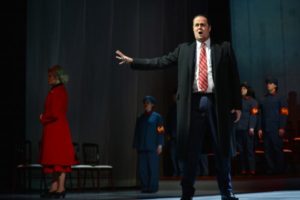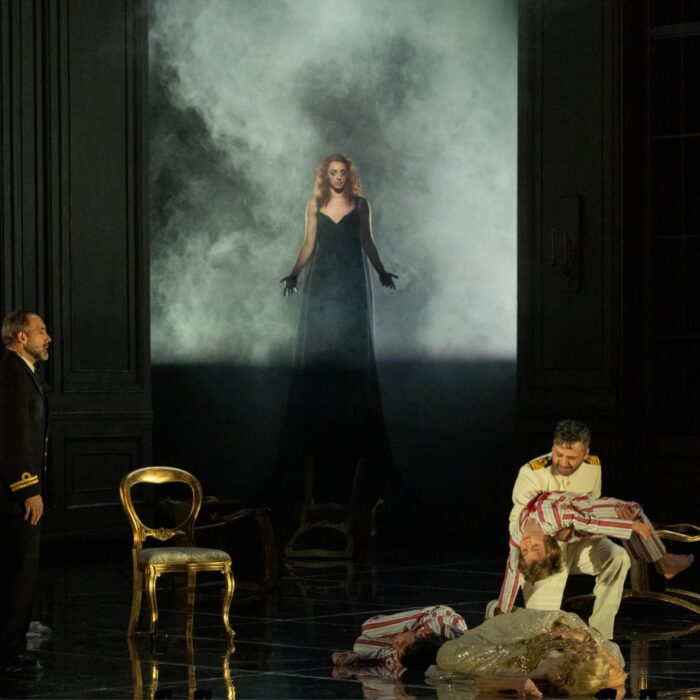
Princeton Festival 2019 Review: Nixon in China
A Strong Portrayal Of One Of the 20th Century’s Best Operas
By Greg Moomjy(Credit: Jessi Oliano)
In the 21st century when opera is perceived as elitist and out-of-touch with contemporary issues, there are many hated buzz words which encapsulate hurdles that modern opera companies must meet if they want to survive. “Relevancy” is one such buzz word. In a society that is far-removed from the aristocracy, powdered wigs and hoop skirts, common in Mozart’s day, how can composers write operas which speak to modern audiences? Implicit in that question are a few others: what does our contemporary mythology consist of if not Julius Caesar or Attila the Hun, who are the cultural figures that everyone knows which embody our values as a society?
Composer John Adams came up with one very compelling answer.
In 1987, with “Nixon In China,” he gave birth to what is now known as ‘The CNN Opera.” These are based on contemporary political figures and headliners. Nixon turned out to be the first part of a trio of operas based on flashbulb points in modern American history, including “The Death of Klinghoffer” and “Doctor Atomic,” based on J. Robert Oppenheimer and the philosophical issues surrounding the Atomic Bomb.
Zeroing In on Nixon
It is fitting that “Nixon in China” should be performed as part of this year’s Princeton Festival. The opera is more than a glamorization of Nixon’s trip to communist China in 1972. Adams used the French Grand Operas of the 19th century as his model, consequently, the two leading couples at the heart of the work, Richard and Pat Nixon and Chairman and Madame Mao, represent their respective countries while coming up against the tide of political events. Additionally, Nixon’s first aria makes a case for the role that news plays in making history, which of course, speaks to our current climate.
Each of the opera’s three acts examines a different angle of Nixon’s historic trip to China, which, let us not forget, was only seven days long, while simultaneously illustrating a different facet of the conflicts that inevitably arise when two cultures meet.
Act one is replete with the pomp and circumstance of the first couple’s arrival in China. However, despite the ceremonies and the banquets, Nixon’s meeting with Mao and his advisors is fraught with tension beneath the surface.
Act two shows Pat Nixon on a state sponsored propaganda tour. However, things go awry when the first Lady is unnerved by a performance of the red detachment of women, a ballet organized by Madame Mao. This ballet depicts the ill-treatment of women at the hands of corrupt landlords. Here Adam’s use of the ballet allows the characters to interact directly with historical events. Pat Nixon shows her disgust. Her husband tries to overlook it, claiming it’s just a ballet. Madame Mao becomes angry when the ballet isn’t performed to her standards, and chaos ensues.
The ability to interact on multiple levels with a historical event is a key feature of French grand opera. The ballet of “Nixon in China” plays much the same role as the card game between Charles VI and Joan of Arc in Halevy’s opera named for that king. The two characters play war with a deck containing images of royal French heads of state. This allows a weak Charles VI to insert himself directly into France’s royal lineage.
Lastly, In Act three, which takes place the evening before the president and first lady depart Beijing. The opera offers an intimate look at each of the opera’s leading characters in isolation by depicting each of these monumental figures, without their political stature and with their own problems and challenges to face.
Full of Tension
Conductor Richard Tang Yuk presented the audience with a reading of Adam’s score that was full of tension even in moments of sweetness, or optimism, reflecting strain on personal and political relationships. He made the most of the opera’s many crescendos.
Additionally Adams creates several scenarios which lend themselves to the spectacle which is so typical of French Grand Opera. Not only is there a requisite ballet, but there is a grand banquet scene at the end of Act one, not only for the principal characters but sizeable choral forces, as well.
As President Richard Nixon, Sean Anderson, exude optimism but also concern for the future in his legacy. He was a great foil for Cameron Schutza, who played Chairman Mao. In interviews, Adams had said that Chairman Mao is a heldentenor. However, if you’re looking for a strong bright easy sound, like Siegfried or Fidelio’s Florestan, Adam’s Mao would be very disappointing. The composer envisioned the Chinese leader as aging and slightly paranoid. Someone who relives his days as a great leader instead of continuing to be one. As such it was extremely appropriate that Schutza sounded slightly strained.
Here the chorus, which functions as the voice of the Chinese people, as well as Mao’s propaganda machine, was appropriately imposing. They bought pungency to their staccato phrases, particularly in Act I. Both John Viscardi and Joseph Barron as Premier Chou En-Lai and Henry Kissinger respectively gave solid performances. It was a joy to hear Viscardi’s strong voice, particularly in his final aria, which ends the opera.
Minimized Women
Teresa Castillo, as Madame Mao, was appropriately frigid during her coloratura of passages, most notably, during her aria, “I am the wife of Mao Tse-tung.” Yet she could also be oddly vulnerable, as in Act three. The contrast between the two was underlined by Soprano Rainelle Krause, whose sweet clear voice showcased Pat Nixon’s altruism and slight naivety.
However, it’s unfortunate that given the importance that these two women have in the opera, at times, they were difficult to see on stage, minimizing the importance of their roles. The decision to have Pat Nixon watch the ballet from backstage was slightly misguided. Her disgust at the treatment of Chinese women is such a crucial part of the scene but until her outburst, it was had to tell where exactly she was.
Much the same could be said, although to a lesser extent of Madame Mao. I understand the decision to costume her in dark colors, but having her sing from the shadows, during the beginning of Act three, caused a slight letup in dramatic momentum.
Merits & Flaws
Taken as a whole, the production, directed by Steven LaCosse, had merits as well as flaws. The decision to have Mao’s funeral bookend the opera led to a powerful conclusion, especially when Chou En-Lai asks, “Was this good?” But in the beginning, it led to confusion as Nixon’s arrival on the Spirit of 76 comes on the heels of the opening chorus. Therefore the funeral made one wonder exactly which high ranking communist official had died; surely, it couldn’t be Mao, not with Nixon’s arrival so soon.
The video projections, directed by Jonathan Dahm Robertson, showed just how much this meeting truly was a clash of cultures. For example, the portrait of Mao was ever-present. It was even outlined behind an image of blue sky, which undercut Nixon’s optimism during his meeting with the Chairman. Images of the terracotta warriors, anti-segregation protesters from the American south, bombs dropping over Vietnam, and the presidential seal of the United States, showed not only the nationalistic implications of this meeting, but also helped to situate Nixon’s trip to China in the context of other contemporary watershed events.
Despite the effectiveness of these images, there were times when the videos felt lacking. For instance, during Pat Nixon’s Act two scena which depicts her state sponsored tour of Peking, there were no opulent images of when she arrives at the Ming Tombs. This felt especially lacking, as the grandeur of the tombs is what prompts her aria, “This is Prophetic!”
Additionally, the lighting by Norman Coates could be somber and downright hellish when called for. As the red lights, which reflect off the red curtains during the ballet performance. In Act three, the shadowy writing reflected the slight dejection of the characters. However, the staging of this act was not as effective as Peter Sellars’ 2011 Met staging of the opera. There, Act three simply consisted of a long row of beds with wide gaps in between. This served as a greater depiction of each character’s isolation.
On the whole, despite some lapses in the production, this was a strong performance which made the case at “Nixon in China” as one of the great American operas of the 20th century, an accolade which this opera most definitely deserves.


